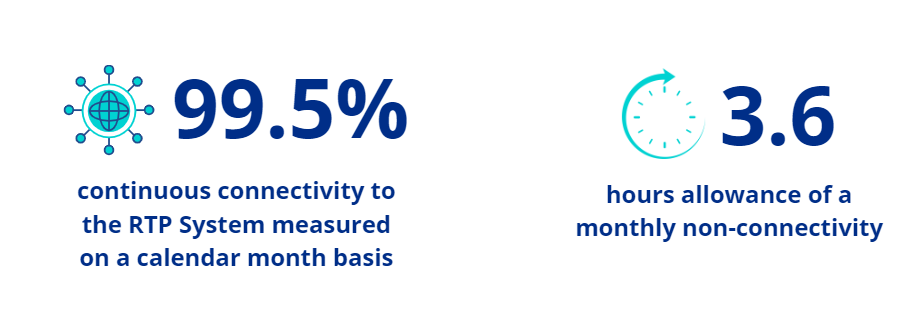Q1 of 2023 witnessed 52 million RTP transactions worth $25 billion. Financial institutions are rapidly embracing instant payments, recognizing the indispensability of speed and convenience in every transaction.
A number of banks use Third-Party Service Providers (TPSPs) to access instant payment services on the RTP network from The Clearing House. These TPSPs enable end-to-end payment processing, from initiation to settlement. Some TPSPs come with pre-tested and fully certified connections, accelerating the adoption process.
Our RTP expert, Kasi Annamalai, answers crucial questions about the technical certification needed for participating in the RTP network through TPSPs.
1. What does the testing process entail when a bank chooses to partner with a TPSP for the provision of RTP services?
There are two levels of testing that we do as a TPSP:
- We undergo a pre-certification process conducting several tests for our messaging and technical connections
- We subsequently proceed to the TCH bank test environment for comprehensive testing. Once certified in the bank test environment, banks can seamlessly transition to the production environment.
There are continuous operation requirements stipulated by the network providers to participants. By entrusting these responsibilities to TPSPs, financial institutions can focus on their business priorities without the need to worry about these evolving specifications.
Some of the requirements include:
- A 99.5% continuous connectivity to the RTP System measured on a calendar month basis
- Allowance of a monthly non-connectivity of approximately 3.6 hour

Additionally, TCH expects that participants work towards implementing 99.9% continuous connectivity that is to be stipulated at a future date. More details can be found here.
3. Does the TPSP’s technical certification suffice for the financial institution?
Yes. By definition, TPSPs can act on behalf of a participant, to transmit and receive Payment Messages, Responses and Non-payment Messages through the RTP System and may also conduct technical testing as agent of Participant using the RTP Test Solutions. For instance, if a financial institution uses Finzly as a TPSP, the bank can utilize Finzly’s certified solutions to quickly transition to the RTP production environment.
In addition to facilitating the transmission of RTP payments between the TCH network and financial institutions, a TPSP like Finzly may offer supplementary services to ensure compliance with the RTP Operating Rules. They can provide participants' customers with a frontend interface and handling various back-office operations, such as round-the-clock support for payment processing, formatting and routing RTP Payments and other messages to the RTP System via an electronic connection managed by the TPSP. Additionally, TPSPs may collaborate with the Funding Agent to oversee the liquidity requirements of RTP participants for the payments they send and receive through the TPSP.
TCH expects participants to test and validate the RTP Technical Specifications, including updates and changes to the specifications, as directed by TCH from time to time. If TPSPs have been designated, they repeat the precertification and the bank testing to adhere to the new technical specifications.
Receiving participants must immediately respond to a Payment Message (with an “Accept,” “Reject” or “Accept without Posting” message), as specified in the RTP Technical Specifications. They are also responsible for providing immediate funds availability to the relevant customer's account, along with relevant status updates. As TPSPs, Finzly meets all these obligations.
Each instant payment initiation must use multi-factor authentication to verify the identity of customers who initiate RTP Payments. The participant is also obligated to provide the Sender with the Receiver’s name in case the payment is originated from a consumer account. Additionally, a reasonable OFAC compliance program is expected to promote and monitor compliance. TPSPs like Finzly, apart from doing the above, also validate that the receiving banks are on the RTP network and take appropriate action.
The RTP message personas are “Receive Payment”, “Send Payment”, “Receive RFP” and “Send RFP.”
Yes, there are other rules that also require regular audits. Example:
-
Transaction limit: An RTP Payment may not exceed the general transaction limit of $1,000,000
-
Message Expiration and Timeout: Participants have 5 seconds to respond to any message that requires a response.
The complete set of operating rules are available here.
There is a noticeable gravity towards TPSPs in the realm of RTP services, as they alleviate banks from the onus of maintaining technical infrastructure. This enables banks to concentrate their efforts on delivering outstanding banking services that cater to the demands of their customers.
“As we direct our efforts towards commercializing the RTP service, our TPSP takes charge of the technical responsibilities. This entails adhering to operational rules and facilitating the seamless integration of overlay services by leveraging APIs on a scalable and contemporary infrastructure.”
CTO of a mid-sized bank that is live on the RTP network
Interested in accelerating RTP/FedNow adoption at your FI using Finzly as the TPSP?

